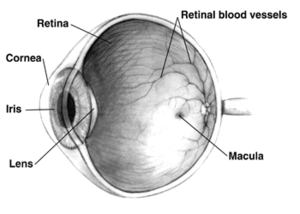Charles Schepens

Charles Louis Schepens (March 13, 1912 - March 28, 2006)[1] was an influential Belgian (later American) ophthalmologist, regarded by many in the profession as "the father of modern retinal surgery",[2][3] and member of the French Resistance.
Early life: medical training and member of the French Resistance
Schepens was born in Mouscron, Belgium in 1912;[2] his father was a physician.[4] He initially studied mathematics before graduating from medical school in 1935 at State University of Ghent in Belgium.[2][3] Schepens then trained in ophthalmology at Moorfields Eye Hospital in London, England prior to World War II.[2][3] After the Germans invaded Belgium in 1940, he became a medical officer in the Belgian Air Force[3]
After the fall of Belgium, Schepens escaped to France where he became active in the French Resistance smuggling documents and people over the Pyrenees to Spain during 1942 and 1943.[3] Schepens was twice captured by the Gestapo.[3] He worked under the alias of Jacques Perot, a lumber mill operator in the French Basque village of Mendive.[5] Aware that the Germans had learned of the operation, he escaped to England.[5]
Ophthalmologist, retinal specialist, and inventor
After the war, Schepens resumed his medical career at Moorfields.[3] In 1947, he immigrated to the United States and became a fellow at the Harvard Medical School.[3] Schepens is credited for creating the vitreo-retinal subspecialty in ophthalmology.[2] In 1949, he established the world's first retina service and first retinal disease fellowship at the Massachusetts Eye and Ear Infirmary.[2][3] He founded a research laboratory for the investigation of retinal disease, the Retina Foundation, in 1950. Now known as the Schepens Eye Research Institute , it is affiliated with Harvard[3] and the Massachusetts General Hospital. It has grown from 6 staff initially to 200 as of 2006,[6] and at that time was the largest independent eye research organization in the United States. In 2011, the institute combined with the Massachusetts Eye and Ear Infirmary.[7]
In 1967, Schepens founded The Retina Society and was its first president from 1968 to 1969.[2]
Schepens invented the binocular indirect ophthalmoscope (BIO), which is routinely used to look at the retina. His original BIO is now in the collection of the Smithsonian Institution.[2] It has been reported that Schepens assembled the prototype for his BIO from metal scraps collected from the streets of London during the German blitz.[8] He was also a pioneer of surgical techniques such as scleral buckling for the repair of retinal detachments. The use of these techniques has raised the success of retinal reattachment surgery from 40% to 90%.[3] During his career, Schepens wrote four books and over 340 research papers.[3]
Awards and recognition
In 1999, Schepens was chosen by the American Society of Cataract and Refractive Surgery as one of the ten most influential ophthalmologists of the century.[3] The American Academy of Ophthalmology named him as one of their inaugural laureates in 2003 as recognition for his contribution to the field.[3] In 2006, his earlier heroics were also rewarded when the consul general of France presented him the French Legion of Honour award for smuggling over 100 people from France into Spain.[5]
His life's story has been told in Meg Ostrum's 2004 book, "The Surgeon and the Shepherd: Two Resistance Heroes in Vichy France".[9] In 2006, Schepens died of a stroke at the age of 94.[5]
In 2013, a biographical profile of Dr. Schepens was included in a bestselling book called Saving Sight: An eye surgeon's look at life behind the mask and the heroes who changed the way we see, by Andrew Lam (author), M.D.[10]
References
- ↑ Thiery M (2008). "Charles Louis Schepens (1912-2006) en het criswick-schepenssyndroom. Tijdschrift boor Geneeskunde". 64 (7): 373.
- 1 2 3 4 5 6 7 8 "33rd Annual Meeting" (PDF). The Retina Society. Archived from the original (PDF) on 2007-06-21.
- 1 2 3 4 5 6 7 8 9 10 11 12 13 14 American Academy of Ophthalmology. 2003 Laureate Award Archived June 13, 2010, at the Wayback Machine..
- ↑ "Archived copy" (PDF). Archived from the original on January 31, 2005. Retrieved 2006-04-07.
- 1 2 3 4 "War-hero eye surgeon dies at 94". Archived March 3, 2016, at the Wayback Machine. IrishExaminer.com. 6 April 2006.
- ↑ New England Ophthalmological Society. ""Charles L. Schepens, M.D."". Archived from the original on October 9, 2007. Retrieved 2006-04-06. Adapted from NEOS biography by Hal M. Freeman.
- ↑ Schepens Eye Research Institute. ""History - Schepens Eye Research Institute"". Archived from the original on 2017-10-04. Retrieved 2017-10-04. History - Schepens Eye Research Institute
- ↑ HistoryWired: A few of our favorite things Archived September 5, 2015, at the Wayback Machine.
- ↑ Amazon.com: The Surgeon and the Shepherd: Two Resistance Heroes in Vichy France (9780803235731): Martha (Meg) G Ostrum: Books
- ↑ Lam, Andrew. Saving Sight: An eye surgeon's look at life behind the mask and the heroes who changed the way we see (978-1617203794) Bokeelia, FL; Irie Books, 2013.
External links
- Joseph P. Kahn. "The escape artist: For this war hero, discretion was the better part of valor." at the Wayback Machine (archived January 31, 2005) Boston Globe. April 15, 2004.
- Schepens Eye Research Institute
- Schepens Retina Associates Foundation
- Schepens International Society
- Nahant Lions Club - Charles L. Schepens Award at the Wayback Machine (archived February 6, 2007)